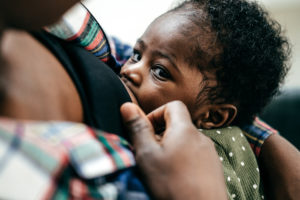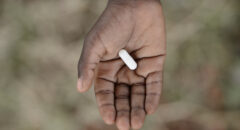
It appears as if the first reported case of HIV being transmitted from a mother to a child was in 1985 when a Hemophiliac (person with a blood clotting disorder) infected his wife, who passed the infection to the infant. Since this early report, millions of babies have been born infected, and millions have died. But the improvements over the decades have been dramatic!
How often is HIV transmitted from mother to baby and how does this happen? Can it be prevented?
It really depends on a number of factors but in general, if there is no medical intervention, somewhere between 20% and 30% of babies born to a mother with untreated HIV-infection will be infected. So, chances are that a mother will not infect her baby, but chances of 1 in 4 are not particularly good odds when dealing with a deadly infection.
In order to improve the odds, we have to know where infection occurs in gestation and birth. While some transmission can occur while the fetus is in the womb, most infections occur when the infant contacts the infected blood of the mother during delivery. This was important to know.
RELATED: CDC's Latest HIV Data Shows Decline In Diagnoses Among Black Women
The first strategy to prevent infection of the baby was to avoid delivery through the birth canal by having a Caesarian delivery. While this may have been an option in the US and Europe, it was definitely not an option in developing countries. So what now?
The next big advanced occurred more than 30 years ago. Zidovudine (AZT) was the first drug approved for use in treating HIV. By itself, it is one of the weakest HIV medicines and has a number of side-effects. But we soon learned that AZT alone could reduce the risk of HIV transmission to a baby from an average of 25% down to about 8%.
This is a three-fold reduction of risk and the drug could literally be administered to the mother for the first time, intravenously during delivery and still work.
As combination therapy became available, we learned that if the mother was on therapy and undetectable at the time of delivery, the risk of transmission was extremely low (yes, U=U). Again, that’s great news; if you’re in a country where you can get combination therapy.
Sadly, that was not an option in most developing countries, even when it was the standard of care in the US and Europe. The breakthrough for low-income countries came in 2000 when it was discovered that a single dose of the HIV drug nevirapine given during delivery could reduce the rate of infection to the infant down to about 1%!
This intervention was inexpensive and low-income countries could afford it. While this was a tremendous victory, it was sort of a hollow victory to protect the baby from getting infected, but not be able to provide the mother with life-saving medications.
RELATED: Pregnancy Complications Rising in Black Women, 5 Ways to Lower Your Odds
At the same time, while we were fighting to get these valuable medicines in developing countries, our policies on treating adults were evolving. Throughout most of the time HIV treatment has been available, people who were relatively” healthy” (had higher numbers of CD4+ cells) were felt not to need therapy.
So if a woman had HIV and was pregnant, she would be given medicines to protect the baby, even though she wouldn’t normally require treatment. After delivering a healthy baby, the medicines could be stopped until her immune system began to decline.
More recently, science from many important clinical studies has taught us that ALL infected patients should be on treatment no matter how “healthy” their immune system is. We believe that everyone benefits from treatment even very early in the infection and, importantly, being on treatment will prevent a person from infecting others.
In developing countries, as HIV medicines become more widely available, the options for treating mothers to prevent infection of the infant improved. At first, countries only had zidovudine or nevirapine that could be given during birth in hospitals to prevent infecting the babies (although about 50% of infants were born at home using mid-wives).
As I stated before, there were no drugs available for the mother. What are the chances of survival for the infant if their mother died?
The next serious problem occurred after birth. If the medicines had successfully protected the baby from getting infected, they weren’t out of the woods yet. Breast-feeding, the healthiest option for babies in developing countries, unfortunately, provides another opportunity for the baby to get infected.
So these babies would need to receive products like zidovudine syrup or nevirapine syrup to prevent their moms from infecting them during breastfeeding. This use of HIV medicines is likely the first example of PrEP (pre-exposure prophylaxis), but in this case, the exposure comes from feeding and not from a high-risk sexual encounter.
The best scenario is if the mother is controlled on effective HIV meds. Then, transmission can’t occur through breast milk (Say it…. “U=U”).
About 6 years ago, many developing countries started one of two options: A) HIV-infected Pregnant women would receive HIV meds until delivery B) HIV-infected pregnant women would receive HIV meds through the pregnancy and continuing through their lives. The second option is more ideal and in line with the current guidelines for treating everyone.
The protection of infants from mother-to-child HIV transmission is one of our victories, there are still babies who get infected by this route every year. In 2016, it is estimated that 160,000 babies were infected during birth. During that same year, an estimated 120,000 children died from AIDS-related complications.
Some women still may not have access to treatment. In other cases, the virus in the mother’s body could be resistant to the medications putting the babies at risk for infection. There is still plenty of work to be done before we can get to ZERO infected babies born!
 Dr. Crawford has over 25 years of experience in the treatment of HIV. While at Howard University School of Medicine, he worked in two HIV-specialty clinics at Howard University Hospital. He then did clinical research as a visiting scientist with the AIDS Clinical Trials Group (ACTG) at Johns Hopkins University School of Medicine. He served as the Assistant Chief of Public Health Research with the Military HIV Research Program where he managed research studies under the President’s Emergency Plan for AID Relief (PEPFAR) in four African countries.
Dr. Crawford has over 25 years of experience in the treatment of HIV. While at Howard University School of Medicine, he worked in two HIV-specialty clinics at Howard University Hospital. He then did clinical research as a visiting scientist with the AIDS Clinical Trials Group (ACTG) at Johns Hopkins University School of Medicine. He served as the Assistant Chief of Public Health Research with the Military HIV Research Program where he managed research studies under the President’s Emergency Plan for AID Relief (PEPFAR) in four African countries.
He is currently working in the Division of AIDS in the National Institutes of Health. He has published research in the leading infectious diseases journals and serves on the Editorial Board of the journal AIDS. Any views and perspectives in his articles on blackdoctor.org are not representative of any agency or organization but a reflection of his personal views.









